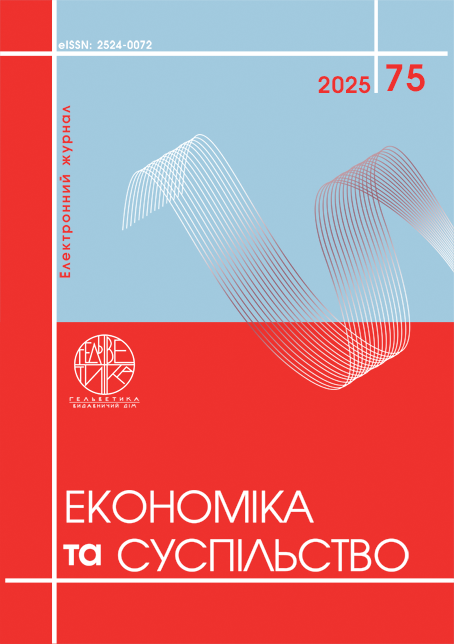A SYNERGETIC APPROACH TO THE APPLICATION OF MONTE CARLO AND BENCHMARKING METHODS IN THE MANAGEMENT OF INFRASTRUCTURE PROJECTS UNDER RECOVERY CONDITIONS
Abstract
The article proposes the integration of the Monte Carlo method and the benchmarking method as a synergistic tool for the effective management of infrastructure projects in the context of the post-war recovery. The focus is on improving decision-making under uncertainty, constrained financial and material resources, and growing public demand for accountability and transparency in project implementation. The Monte Carlo method enables the simulation of multiple development scenarios, taking into account the variability of input parameters and identifying critical impact factors that may significantly influence project outcomes. The benchmarking method is applied to compare the current project case with recognized best practices and performance indicators from similar infrastructure initiatives. This comparative approach helps in setting realistic goals, calibrating expectations, and identifying areas for improvement in the planning and execution of reconstruction efforts. The proposed integrated model enhances the quality of strategic planning, improves adaptability to rapidly changing conditions, and increases the accuracy of investment efficiency assessment. The article also highlights the model’s ability to support proactive risk management, improve accountability mechanisms, and facilitate the rational allocation of available resources in post-conflict settings. Particular emphasis is placed on the role of data-driven tools and evidence-based decision-making in strengthening institutional capacity during the recovery phase. Practical testing of the approach was conducted based on the reconstruction of civil infrastructure objects in Ukraine, including pilot facilities supported by international donors worldwide. The results confirmed the effectiveness, flexibility, and practical relevance of the synergy between these two methods. The model proved valuable in optimizing resource utilization, reducing uncertainties, strengthening project resilience, and contributing to long-term socio-economic sustainability and institutional recovery in war-affected regions.
References
Світовий банк. Рамкова концепція стійкої інфраструктури: Поняття та індикатори. Вашингтон: Світовий банк, 2022. URL: https://openknowledge.worldbank.org (дата звернення: 25.05.2025)
Європейський банк реконструкції та розвитку (ЄБРР). Звіт про трансформацію 2022–2023: Бізнес як незвично. Лондон: ЄБРР, 2022. URL: https://www.ebrd.com/publications (дата звернення: 25.05.2025)
Фонд реконструкції Іраку. Аналіз вартості післявоєнної відбудови в галузях освіти та охорони здоров’я. Багдад: REFA, 2021. URL: https://unterm.un.org/unterm2/ar/view/1000e37d-c4ce-4857-81f3-f8a943cda1b5 (дата звернення: 15.06.2025).
Програма розвитку ООН (ПРООН). Відбудова в Хорватії: Оцінка післявоєнного періоду. – Нью-Йорк: Офіс оцінювання ПРООН, 2005. URL: https://erc.undp.org/evaluation/documents/download/208 (дата звернення: 07.06.2025)
Transparency International. Глобальний звіт про корупцію: інфраструктура та будівництво. Берлін: TI, 2022. URL: https://www.transparency.org (дата звернення: 14.06.2025)
Open Contracting Partnership. Громадська участь у нагляді за інфраструктурою: кейси України та Балкан. 2021. URL: https://www.open-contracting.org (дата звернення: 08.06.2025)
Міжнародна фінансова корпорація (IFC). Впровадження BIM у країнах, що розвиваються: кейси та ключові показники ефективності (KPI). Вашингтон: Група Світового банку, 2022.
Брінкергофф Д. В. Відновлення системи управління у державах, що зазнали краху, та післяконфліктних суспільствах: основні поняття та наскрізні теми. Public Administration and Development. 2005. № 25(1). С. 3–14. DOI: https://doi.org/10.1002/pad.352 (дата звернення: 25.05.2025)
Дель Кастільйо Г. Країни, зруйновані війною, природні ресурси, інвестори з країн, що розвиваються, та система розвитку ООН. Third World Quarterly. 2014. № 35(10). С. 1911–1926. DOI: https://doi.org/10.1080/01436597.2014.971610 (дата звернення: 21.06.2025)
Квак Ю. Х., Інгалл Л. Дослідження застосування методу Монте-Карло в управлінні проєктами. Risk Management. 2007. № 9(1). С. 44–57. DOI: https://doi.org/10.1057/palgrave.rm.8250017 (дата звернення: 07.06.2025)
Vose D. Risk analysis: A quantitative guide. 3rd ed. Chichester: John Wiley & Sons, 2008. 752 c.
Mak S., Picken D. Using risk analysis to determine construction project contingencies. Journal of Construction Engineering and Management. 2000. Vol. 126 (2). P. 130–136. DOI: https://doi.org/10.1061/(ASCE)0733-9364(2000)126:2(130) (дата звернення: 26.05.2025)
Кемп Р. С. 1989. Бенчмаркінг: пошук найкращих галузевих практик, що забезпечують високу ефективність. Мілвокі: ASQC Quality Press. 320 с.
Шумейко В. В. Застосування методу Монте-Карло для оцінки вартості інвестиційного проєкту. Економіка і організація управління. 2020. № 3(39). С. 75–82.
World Bank Group. Framework for Resilient Infrastructure: Concepts and Indicators [Washington: World Bank, 2022] Available at: https://openknowledge.worldbank.org (accessed May 25, 2025)
European Bank for Reconstruction and Development (EBRD) [Transition Report 2022–2023: Business Unusual] London: EBRD, 2022 Available at: https://www.ebrd.com/publications (accessed: May 25, 2025)
Iraq Reconstruction Fund. [Post-war Reconstruction Cost Analysis in Education and Health Sectors] Baghdad: REFA, 2021. Available at: https://unterm.un.org/unterm2/ar/view/1000e37d-c4ce-4857-81f3-f8a943cda1b5 (accessed June 15, 2025)
United Nations Development Programme (UNDP) [Reconstruction in Croatia: Post-War Evaluation Report] New York: UNDP Evaluation Office, 2005. Available at: https://erc.undp.org/evaluation/documents/download/208 (accessed June 07, 2025)
Transparency International. [Global Corruption Report: Infrastructure and Construction] Berlin: TI, 2022. Available at: https://www.transparency.org (accessed June 14, 2025)
Open Contracting Partnership. [Civic Participation in Infrastructure Oversight: Ukraine and Balkans Cases 2021] Available at: https://www.open-contracting.org (accessed June 08, 2025)
International Finance Corporation IFC (2022). BIM Implementation in Developing Countries: Case Studies and Key Performance Indicators [BIM Implementation in Developing Countries: Case Studies and Key Performance Indicators] Washington: World Bank Group.
Brinkerhoff D. W. (2005) Vidnovlennia system upravlinnia u nespromozhnykh ta postkonfliktnykh suspilstvakh: kliuchovi kontsepty ta naskrizni temy [Rebuilding Governance Systems in Failed and Post-Conflict Societies: Key Concepts and Cross-Cutting Themes]. Public Administration and Development. vol. 25(1). pp. 3–14. DOI: https://doi.org/10.1002/pad.352 (accessed May 25, 2025)
Del Castillo G. (2014) Krainy, spustosheni viinoiu, pryrodni resursy, investory z krain, shcho rozvyvaiutsia, ta systema rozvytku OON. [War Torn Countries, Natural Resources, Developing Country Investors and the UN Development System]. Third World Quarterly. vol. 35(10). pp. 1911–1926. DOI: https://doi.org/10.1080/01436597.2014.971610 (accessed June 21, 2025)
Kwak Y. H., Ingall L. (2007) Monte Carlo Simulation Method Application in Project Management. [Monte Carlo Simulation Method Application in Project Management]. Risk Management. vol. 9(1). pp. 44–57. DOI: https://doi.org/10.1057/palgrave.rm.8250017 (accessed June 07, 2025)
Vose D. (2008) Risk Analysis: A Quantitative Guide. 3rd ed. Chichester: John Wiley and Sons, 752 p.
Mak S., Picken D. (2000) Using Risk Analysis to Determine Construction Project Contingencies. Journal of Construction Engineering and Management. vol. 126(2). pp. 130–136. DOI: https://doi.org/10.1061/(ASCE)0733-9364(2000)126:2(130) (accessed 26.05.2025)
Camp R. S. (1989) Benchmarkinh: poshuk naikrashchykh haluzevykh praktyk, shcho zabezpechuiut vysoku efektyvnist [Benchmarking: The Search for Industry Best Practices that Lead to Superior Performance] Milwaukee: ASQC Quality Press. 320 p.
Shumeiko V. V. (2020) Zastosuvannia metodu Monte-Karlo dlia otsinky vartosti investytsiinoho proiektu. [Application of Monte Carlo method for investment project cost estimation]. Economics and Organization of management, vol. 3(39). pp. 75–82.
Copyright (c) 2025 Алевтина Третякова

This work is licensed under a Creative Commons Attribution 4.0 International License.


